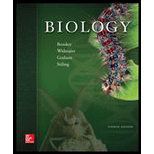
Concept explainers
Introduction: The nervous system can be defined as the system comprising of neurons and fibers that aid in the transmission of nerve impulses across various parts of the body. The nervous system contributes in the maintenance of control and coordination in the body.
Answer to Problem 1TY
Correct answer: In vertebrates, the brain and the spinal cord constitute the central nervous system. Hence, the correct answer is option c.
Explanation of Solution
Reason for correct answer:
The central nervous system is the nervous system that includes the brain and the spinal cord. The central nervous system is responsible for carrying out nearly all the functions related to the body.
Option c is given as “the central nervous system”.
The brain and the spinal cord together make up the central nervous system. Hence, the correct answer is option c.
Reasons for incorrect answer:
Option a is given as, “the peripheral nervous system”.
The peripheral nervous system comprises of the cranial nerves and spinal nerves. The brain and spinal cord are not a part of it. Hence, option a is incorrect.
Option b is given as, “the efferent division of the nervous system”.
The efferent neurons do not form any system rather they are only responsible for carrying information from the brain and spinal cord to the different organs. Hence, option b is incorrect.
Option d is given as, “the autonomic nervous system”.
The autonomic nervous system is a part of the peripheral nervous system. In vertebrates, brain and the spinal cord do not constitute the autonomic nervous system. Hence, option c is incorrect.
Option e is given as, “the central and peripheral nervous system”.
The central nervous system comprises of the brain and the spinal cord. They are not a part of the peripheral nervous system. Hence, option e is incorrect.
Hence, the options a, b, d, and e are incorrect.
In vertebrates, the central nervous system is made up of brain and the spinal cord.
Want to see more full solutions like this?
Chapter 41 Solutions
Biology
- Give examples of fat soluble and non-fat soluble hormonesarrow_forwardJust click view full document and register so you can see the whole document. how do i access this. following from the previous question; https://www.bartleby.com/questions-and-answers/hi-hi-with-this-unit-assessment-psy4406-tp4-report-assessment-material-case-stydu-ms-alecia-moore.-o/5e09906a-5101-4297-a8f7-49449b0bb5a7. on Google this image comes up and i have signed/ payed for the service and unable to access the full document. are you able to copy and past to this response. please see the screenshot from google page. unfortunality its not allowing me attch the image can you please show me the mathmetic calculation/ workout for the reult sectionarrow_forwardIn tabular form, differentiate between reversible and irreversible cell injury.arrow_forward
- 1.)What cross will result in half homozygous dominant offspring and half heterozygous offspring? 2.) What cross will result in all heterozygous offspring?arrow_forward1.Steroids like testosterone and estrogen are nonpolar and large (~18 carbons). Steroids diffuse through membranes without transporters. Compare and contrast the remaining substances and circle the three substances that can diffuse through a membrane the fastest, without a transporter. Put a square around the other substance that can also diffuse through a membrane (1000x slower but also without a transporter). Molecule Steroid H+ CO₂ Glucose (C6H12O6) H₂O Na+ N₂ Size (Small/Big) Big Nonpolar/Polar/ Nonpolar lonizedarrow_forwardwhat are the answer from the bookarrow_forward
- what is lung cancer why plants removes liquid water intead water vapoursarrow_forward*Example 2: Tracing the path of an autosomal dominant trait Trait: Neurofibromatosis Forms of the trait: The dominant form is neurofibromatosis, caused by the production of an abnormal form of the protein neurofibromin. Affected individuals show spots of abnormal skin pigmentation and non-cancerous tumors that can interfere with the nervous system and cause blindness. Some tumors can convert to a cancerous form. i The recessive form is a normal protein - in other words, no neurofibromatosis.moovi A typical pedigree for a family that carries neurofibromatosis is shown below. Note that carriers are not indicated with half-colored shapes in this chart. Use the letter "N" to indicate the dominant neurofibromatosis allele, and the letter "n" for the normal allele. Nn nn nn 2 nn Nn A 3 N-arrow_forwardI want to be a super nutrition guy what u guys like recommend mearrow_forward
 Comprehensive Medical Assisting: Administrative a...NursingISBN:9781305964792Author:Wilburta Q. Lindh, Carol D. Tamparo, Barbara M. Dahl, Julie Morris, Cindy CorreaPublisher:Cengage Learning
Comprehensive Medical Assisting: Administrative a...NursingISBN:9781305964792Author:Wilburta Q. Lindh, Carol D. Tamparo, Barbara M. Dahl, Julie Morris, Cindy CorreaPublisher:Cengage Learning Medical Terminology for Health Professions, Spira...Health & NutritionISBN:9781305634350Author:Ann Ehrlich, Carol L. Schroeder, Laura Ehrlich, Katrina A. SchroederPublisher:Cengage Learning
Medical Terminology for Health Professions, Spira...Health & NutritionISBN:9781305634350Author:Ann Ehrlich, Carol L. Schroeder, Laura Ehrlich, Katrina A. SchroederPublisher:Cengage Learning Human Physiology: From Cells to Systems (MindTap ...BiologyISBN:9781285866932Author:Lauralee SherwoodPublisher:Cengage Learning
Human Physiology: From Cells to Systems (MindTap ...BiologyISBN:9781285866932Author:Lauralee SherwoodPublisher:Cengage Learning Concepts of BiologyBiologyISBN:9781938168116Author:Samantha Fowler, Rebecca Roush, James WisePublisher:OpenStax College
Concepts of BiologyBiologyISBN:9781938168116Author:Samantha Fowler, Rebecca Roush, James WisePublisher:OpenStax College





